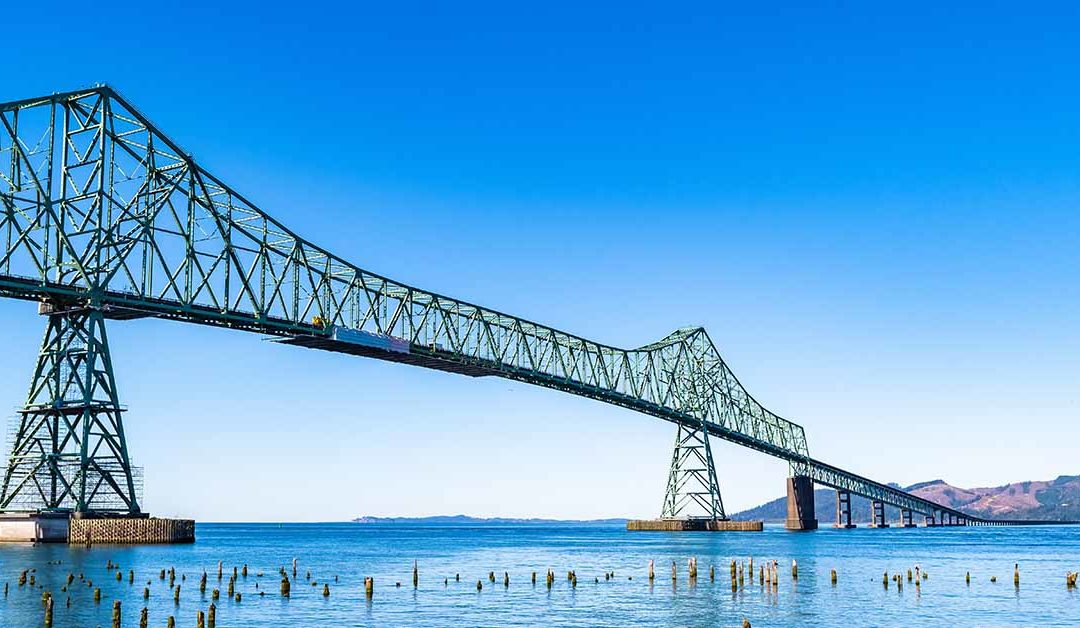This is an article about panic; the type of panic that is attached to particular places or experiences (fear of heights, fear of dentists, fear of public speaking). This type of panic is quiescent…until we come into contact with the panic trigger. Since we can often side-step panic triggers, i.e., by not going to the dentist, they remain unexamined and unhealed until a lifestyle change brings us face to face with the panic. This is my personal story of panic uncovered and healed—by needing to cross a very particular bridge.
The Astoria-Megler Bridge spans 4 miles across the mouth of the mighty Columbia River, connecting Oregon and Washington. When it was completed in 1996, it was the final link of the Pacific Coast Hwy (US 101) from Mexico to Canada. The main bridge section is a 1232 ft long cantilevered truss—the longest truss section in the US. It was built to replace an unreliable ferry (formerly the only way to get across), and to accommodate huge oceangoing tanker ships on their way in and out of Portland OR, a five-hour trip downriver from the bridge. The Oregon side of the bridge, which spans the shipping channel, rises 200 ft into the air, with a 360-degree ascent. The Washington side of the bridge is a causeway, built much closer to the water, for small fishing boats to pass under. That side of the river has salmon and steelhead fish runs that have remained relatively intact.
The first time I encountered this bridge, I went into a full body panic for the 20 minutes it took to cross it. It is a long bridge: eyes glued shut, fists in a ball, breath shallow and rapid. The urge to escape was overpowering. Within my panic-body was a story I was fused with, a story without words yet filled with terrorizing sensations. Whatever actually happened to me when this panic was born, it was before episodic memory…before 4 years old, when my memories begin. But what was the threat? I would occasionally get an image of the bridge vibrating wildly and throwing me off. Just me.
The story felt like a certainty: something unspeakably terrible would happen to (only) me on that bridge.
The summer of 2022 I spent several months on the WA side of the bridge. The necessity of crossing that bridge again and again meant I had to keep experiencing the panic. I began using the tools that I teach—EFT tapping during the crossing to reduce the overwhelming feelings of terror, and self-coaching (talking to myself) with compassion and care. I did not get mad at myself, I got curious. As I kept using EFT tapping every time we crossed, the overwhelm began to subside a little. With less panic, I had the emotional space to be reflective instead of reactive. “Isn’t it interesting I have so much panic crossing the bridge…I wonder what this is about?” This compassionate curiosity began to change my experience of the panic. I began to grieve (weep) when crossing, releasing the storied energy in my limbic body. The more I was able to grieve, the more this “body story” began to unravel. The illogical threat of awful and terrifying experiences happening only to me when thousands of people cross this bridge everyday started to feel less predetermined and more absurd.
When crossing, I would get triggered into panic AND grief. Now I had another emotion to focus on. When I focused on the grief—this was a long bridge, so I had 5-10 minutes of big emotion to self-manage—I could feel the intense pain/grief in my body. The panic was losing its power to dysregulate me. When I allowed myself a grief storm, my self-generated “horrifying bridge tale” lost its power over me. The last time I panicked, the panic dissolved into grief. My body let go of the grief it had been holding onto for sixty years. When the grief was released, the panic left too. In June of 2023, I drove across the bridge, from the Oregon side, with no panic and no grief. The embodied panic story was no longer controlling my nervous system.
What interventions made the difference?
- I had to cross the bridge to go to places I really wanted to visit. This was the most important intervention. If I hadn’t needed to interact with the panic, it wouldn’t have healed. Needing to dive into my panic, again and again, caused the story to loosen. As it began to fray, I felt a sense of being really young when these terrifying experiences happened to me, the experiences the bridge story explained.
- I gave myself compassion when I was in panic, using EFT tapping as I was crossing the bridge. It worked to reduce the overwhelming intensity of the fear; it did not take it away. With less panic I had more room for “looking within”. I had to keep using EFT tapping everytime I crossed the bridge.
- I told myself the truth, without being angry or self-abandoning: “This panic is about something that happened to me when I was so young, I had to make up this illogical story to explain it. I know the story isn’t true, and so my panic is based on a story my body made up to explain something that happened over 60 years ago. There is no danger now.” I kept repeating some version of this truth every time I crossed.
- I made myself look out the window, notice the landmarks around me, while breathing deeply and calmly and reminding myself “the danger was about then, not now.”
My panic was pretty site specific—it happened at this particular bridge everytime we crossed. I did not panic on every bridge (the next bridge upriver, a much shorter span, did not cause this panic.) The panic was like trapped energy—everytime it launched, I shivered and shook and tensed up. When I began to intervene in that energy cycle, by doing EFT tapping for the rising panic I felt when crossing the bridge, the panic and dysregulation subsided enough for me to feel what was happening inside of my body. Once I was able to feel the feelings inside, I was able to give myself compassion for the suffering I endured, instead of trying to control the uncontrollable story spinning out in my body.
Of all the interventions, the most important was necessity. I wanted what was on the other side, and so I was forced to interact with my panic. Everytime, I crossed the bridge, it was another chance to defuse the panic. This is crucial, because panic is so dysregulating that we will go out of our way to avoid it. Understandably. However, when you avoid interacting with the panic, the story cannot change and the deep childhood wounds—which caused the panic– remain unhealed.
This is the message I want to share—we cannot heal our childhood wounds by fleeing from them. We must step into a relationship with our wounds: to engage with the fear, pain, and grief without abandoning ourselves.

